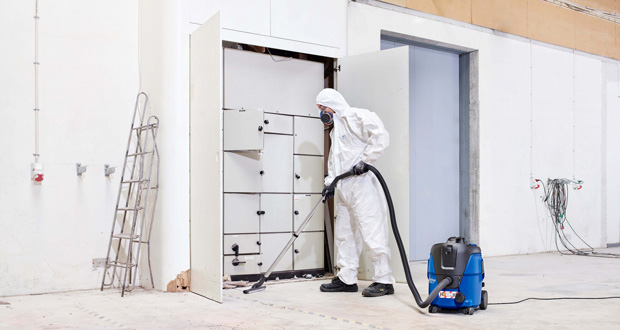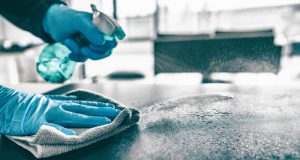As staff attraction and retention continues to be an issue for cleaning operators, creating a health and safety culture that goes beyond pure regulatory compliance could be a strategic response to staffing challenges
Martin Troelsgaard, Global Head of Insights at Nilfisk examines what this means for businesses, how they can put health and safety and smart equipment choices at the core of their cleaning operations and use it to help lessen the talent drain from cleaning.
Finding and then keeping valued employees is a constant issue for cleaning operators. Staff turnover is disruptive to both planning and the delivery of successful contract obligations, but also time consuming to resolve and costly to manage.
A strategic response designed to mitigate ongoing staffing issues should include a more comprehensive approach than one that simply abides by the prevailing health and safety regulations that govern the industry.
Through tackling issues such as the physical strains of cleaning routines and using design-led and intuitive technology solutions to support better health and safety outcomes, staff will feel better connected, more supported and are less likely to opt for alternative employment at a time when retention is a tangible issue for many organisations.
For many operations, efforts to improve health and safety outcomes associated with cleaning responsibilities are now becoming a business priority. A number are actively assessing where improvements can be made to protect employees to support corporate reputations for creating a well-managed and safe place of work.
This increase in focus means health and safety in a cleaning environment is currently viewed just as importantly as the need to complete tasks in a timely and cost-effective manner. Such a priority shift will be welcomed by staff.
Recent research conducted by Nilfisk strongly reinforces the vital importance of a strong health and safety culture and the prominence it holds for cleaning operators as they look to enhance and improve the working experience for employees.
Nilfisk surveyed respondents with purchasing influence on general floorcare cleaning machines from a range of sectors and countries to examine their priorities. The study concluded organisations are proactively upgrading the focus and time they are applying to delivering a robust health and safety environment for their cleaning staff. This is a positive move that can only deliver benefit for staff motivation and loyalty.
Across all markets and industries, 84 per cent of companies said their health & safety focus has ‘increased significantly or slightly’ and 83 per cent of British companies specifically stated this was the case for them.
And other specific areas designed to improve health and safety performance and staff sentiment within cleaning environments were identified as priorities. They should now be used to shape both strategic responses and cleaning operation equipment investments.
The prevention of accidents such as ‘slips and falls,’ as well as increasing disinfection of equipment, alongside efforts to increase the amount of health and safety training provided for staff, are now viewed as priority tasks.
Other critical areas also emerged from the research, including increasing the level of personal protective equipment supplied to staff, improving indoor air quality, and reducing the physical strain of cleaning activities.
And cleaning equipment selection that can aid some of the staff-related health and safety issues highlighted above, also help point to where smart investments can be made by cleaning organisations.
Smart investment – protecting staff
Cleaning machine functionality that can help prevent staff exposure to harmful substances such as wastewater and chemical substances used within the cleaning environment can be an excellent starting point to both assure staff and seek to tackle issues such as insurance costs and potential injury compensation incidents.
This can be supported by the specification of optimal safe operator-machine interaction functions, in tandem with the creation of a proactive sustainable cleaning regime to help preserve good indoor air quality for staff; one that prioritises lower emissions and optimised dust control.
Other areas can also make a significant contribution to staff wellbeing and sentiment within the overall health and safety regime and help to ensure employees stay. These include providing cleaning machine solutions that offer good ergonomic design for operator comfort, as well as safety-first functions such as anti-collision alarms on machines when in proximity to people or objects.
Finally, the advent of robotic cleaning machine solutions can assist with time consuming and physically strenuous cleaning tasks to aid health and safety objectives and support improved productivity.
Appreciation of the safety and productivity benefits that technology solutions such as autonomous cleaning can deliver is now more widely acknowledged and understood. It is helping to inform better decision making about staff and overall resource deployment.
This can mean, in some instances, that companies create the flexibility to reassign employees to other business areas where skill sets and experience can be more effective, as well as offering alternative job opportunity and stimulation for staff.
It is important to recognise that the specification of more ergonomically designed cleaning machines that lessen the physical stresses and strains on cleaning operatives can help to alter perceptions and change the day-to-day working experience for staff who need to be retained.
In a period when the cleaning sector is grappling with acute staff shortages and retention, as well as the costly consequences of people turnover issues, taking positive moves to support workers by making the job easier to fulfil and enjoy within an environment where health and safety is taken seriously, should not be underestimated.





